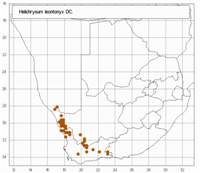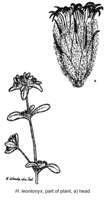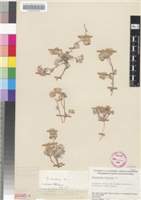Diagnostic characters:
Plants covered in white woolProstrate herbSmall compact round inflorescences supported by a whorl of woolly-hairy leavesBracts with long narrow tips
Description:
Grey-woolly annual herb with a slender taproot, branches 15-150 mm long, many from the crown, simple or much branched, slender, prostrate, often reddish, loosely woolly, distantly leafy but leaves crowded under the heads and at the crown. Radical leaves often withered at flowering, mostly 15-30 x 5-10 mm, oblong-elliptic to spathulate, apex rounded, base narrowed, margins flat, cauline leaves similar, but often smaller, mostly 5-15 x 1.5-6 mm, oblong-elliptic to spathulate, often folded lengthwise, apex recurved, all with both surfaces loosely grey-woolly. Heads heterogamous, campanulate, c. 3-4 x 2-2.5 mm, sessile or shortly pedunculate, crowded in terminal glomerules c. 5-15 mm across. Involucral bracts in 3-4 series, outermost short, webbed with wool to leaves, inner subequal, exceeding flowers, backs woolly, tips usually acuminate, often markedly squarrose, rarely only acute, dull yellow, orange or red, sometimes red above the stereome. Receptacle nearly smooth. Flowers 20-37, (1-) 2-7 female, 18-30 homogamous, yellow, sometimes tipped red. Achenes 0.75 mm long, with myxogenic duplex hairs, or rarely glabrous. Pappus bristles equaling corolla, barbellate above, scabrid below, bases cohering lightly by patent cilia.
Flowers from July to October, mainly in September.
Distribution:
Grows in sand, and will colonize roadsides and old fields. Recorded from the Obibberge in southernmost Namibia near the Orange River, the Springbok area in Namaqualand and the environs of Pofadder further east, south to the Roggeveld escarpment, Ceres and the Little Karoo from Laingsburg east to Willowmore and Uniondale.
Succulent Karoo and Fynbos Biomes.
Notes:
Being a desert annual dependent on erratic rainfall, plants of H. leontonyx are very variable in size, and stems less than 20 mm long will bear clusters of heads. There is also considerable variation in degree of branching and size of glomerules. However, the involucral bracts are generally acuminate with recurved tips; the only exceptions seen are Compton 21147 (NBG) with more or less acute bracts, and Goldblatt 5905A (E; MO; NU) in which the bracts vary from acute to shortly acuminate.
H. leontonyx is frequently found in herbaria under H. tinctum (Leontonyx glomeratus) from which it is most easily distinguished by its small heads and uniseriate pappus, a character calling for careful observation.
Taxonomy:
Literature:
Helichrysum leontonyx DC., Prodr. 6: 169 (1838); Harv. in F.C. 3: 214 (1865); Moeser in Bot. Jb. 44: 296 (1910).
Type:
Cape, Little Namaqualand, Springbok distr., between Kaus Mountains and Gariep, Dr�ge 2843 (G-DC, holo.).
Synonym(s):
Gnaphalium leontonyx (DC.) Sch. Bip. in Bot. Ztg 3: 169 (1845).
Vouchers:
Acocks 16946 (PRE); Compton 11257 (NBG); Esterhuysen 5817 (PRE); Maguire 999 (NBG, STE).

_sml.jpg)
_sml.jpg)
_sml.jpg)
